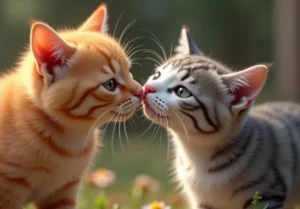Cats: they sneak, they pounce, they munch on things they shouldn’t. Like a tiny, furry James Bond, your cat is on a constant mission to explore and sometimes nibble on the unknown. Just spotted your feline friend eyeing that bamboo plant you love? Before you envision a trip to the vet, let’s figure out if you really need to worry.
In this post, you’ll discover everything you need to know about bamboo and its safety around your furball, finally giving you peace of mind.
Key Takeaways:
- True bamboo, from the Poaceae family, is safe for cats; avoid imposters like “Lucky Bamboo” which are toxic.
- If your cat nibbles on bamboo, observe for symptoms and contact your vet if they ingest a toxic plant lookalike.
- Keep your cat safe around houseplants by using physical barriers, providing safe plant alternatives like cat grass, and training with firm commands.
Is Bamboo Really Safe for Cats?
When it comes to our feline friends and their curious instincts, we pet owners often find ourselves at a crossroads, particularly when picking out houseplants that won’t pose a threat to their health. So, is bamboo safe for our whiskered companions? Yes, but with a crucial distinction that needs to be made clear.
True bamboo, belonging to the Poaceae family, is non-toxic to cats. This is backed by expert veterinarian advice and supported by reputable sources like the ASPCA (American Society for the Prevention of Cruelty to Animals). However, the confusion usually stems from plants labeled as “bamboo” in common vernacular that are not true bamboo and may indeed be harmful to cats. An example of this is the “Lucky Bamboo” (Dracaena sanderiana), which is not a bamboo at all and is toxic to cats.
How Can You Identify Safe Bamboo?
Distinguishing true bamboo from its lookalikes is key to maintaining a safe environment for your cat. Here’s what to look out for:
- Botanical Family: True bamboo belongs to the Poaceae family. Verify the plant’s scientific name before purchase.
- Growth Pattern: Bamboo grows in segments with a distinct hollow stem, known as culms. Unlike its imposters, it doesn’t have leaves growing directly from the segments.
- Texture: True bamboo has a woody texture, differing from the softer, fleshier feel of imposters like Lucky Bamboo.
A unique tip not commonly shared is to look for nodes (the lines across the stem where leaves grow out) that are evenly spaced and clean-cut in appearance, a hallmark of true bamboo.
What Should You Do If Your Cat Eats Bamboo?
Even though true bamboo is non-toxic, it’s not exactly part of a cat’s diet and can cause some gastrointestinal upset if they nibble too much. Here’s what you can do:
- Observe for Symptoms: Keep an eye on your cat for any signs of distress, such as vomiting, diarrhea, or lethargy.
- Check the Plant: Verify if the plant ingested is indeed true bamboo. If it’s a lookalike, such as Lucky Bamboo, proceed with more urgency.
- Vet Time: If your cat shows any worrying symptoms or if you know they’ve ingested a toxic plant, don’t hesitate to contact your vet immediately. Have the plant name ready, as it can help expedite the diagnosis and treatment.
At the end of the day, your cat’s safety is paramount. By choosing your houseplants carefully and keeping an eye on your curious explorer, you can create a safe and stimulating environment for them. Always lean on the side of caution and when in doubt, consult with a professional for peace of mind. Happy plant (and pet) parenting!
How to Keep Your Cat Safe Around Plants
Cats are curious creatures by nature, always eager to explore their environment, which unfortunately often includes sampling our houseplants. While we’ve established that bamboo is not toxic to cats, not all plants are as safe, and we certainly don’t want our feline friends chewing on our decor. So, how can we keep our whiskered companions both safe and entertained, without turning our living spaces into a jungle off-limits? Here are a few tips and tricks that will help you protect both your cat and your greenery.
Use Physical Barriers
One straightforward method to prevent your cat from getting too close to your plants is by using physical barriers. This does not mean turning your home into Fort Knox but adopting creative and subtle solutions such as:
- Plant Covers: For smaller plants, consider using decorative cages or plant cloches. This adds a stylish touch to your decor while keeping your plants out of reach.
- Elevating Plants: Tall plant stands or wall-mounted shelves not only save your plants but also add to your home aesthetics, making your space look airy and more spacious.
Training Your Cat
Yes, cats can be trained, despite their reputation for being independent. Training your cat to stay away from your plants might take some patience, but it’s definitely achievable with consistency. Here’s how:
- Use a Firm “No”: When you catch your cat nibbling on plants, a firm “no” can sometimes be enough to deter them. Be consistent with your commands so they understand the connection between the action and your disapproval.
- Provide Alternatives: Often, cats chew on plants out of boredom. By providing toys that stimulate their predatory instincts, you divert their attention away from your green friends.
Offer Safe Alternatives
Cats chew on plants for various reasons including curiosity, boredom, or to aid their digestion. Offering them safe alternatives can satisfy this natural instinct:
- Cat Grass: Grow a small pot of cat grass for them to nibble on. It’s safe and actually beneficial for their digestion. Plus, it might keep them away from your less desirable foliage.
- Catnip: Many cats adore catnip, and having a designated catnip toy or area might distract them from your plants.
A Unique Tip
Here’s a unique suggestion that most might not consider – implement scent deterrents. Cats are highly sensitive to smells, and they find certain aromas repulsive. Citrus peels around your plants can act as a natural deterrent, as most cats dislike the smell of citrus. This method is an eco-friendly way to keep your curious cat at bay, without resorting to chemicals or expensive solutions.
Incorporating these strategies into your home requires a bit of creativity and patience but remember, the goal is to create a harmonious living space that satisfies both your and your cat’s needs. It’s about making small adjustments that have big impacts, ensuring your furry friend can explore safely without putting themselves or your beloved plants at risk.
By taking these measures, you can enjoy the best of both worlds – a green, thriving home filled with plants, and a happy, healthy cat that’s part of the family. Remember, keeping your cat engaged, entertained, and well-cared for is key to preventing unwanted behaviors, so take this opportunity to strengthen your bond and enrich your pet’s life in safe, fun, and creative ways.
Alex, a passionate animal lover, has experience in training and understanding animal behavior. As a proud pet parent to two dogs and three cats, he founded AnimalReport.net to share insights from animal experts and expand his knowledge of the animal kingdom.





